| Srl | Item |
| 1 |
ID:
130779
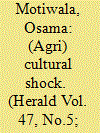

|
|
|
| 2 |
ID:
122578
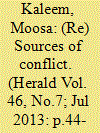

|
|
|
| 3 |
ID:
122539


|
|
|
| 4 |
ID:
139185
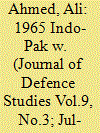

|
|
|
|
|
| Summary/Abstract |
This article seeks to analyse the lessons of the 1965 Indo-Pak war that are applicable today. It finds that the current army doctrine, Cold Start, has some similarities to the opening round of the 1965 war. It argues that even the attritionist strategy adopted in 1965 may have more to give today than the manoeuvre war approach of its more famous successor, the 1971 war. In particular, the article appraises Prime Minister Lal Bahadur Shastri’s firm political control during the war and finds that it was ably reinforced by the prime ministers who were at the helm in India’s later wars. Knowing when to stop is key to avoiding nuclear thresholds, and in that the 1965 war, which stopped short of decisive victory, serves as a suitable precedent to potential future conflicts.
|
|
|
|
|
|
|
|
|
|
|
|
|
|
|
|
| 5 |
ID:
137965
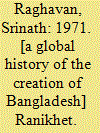

|
|
|
|
|
| Publication |
Ranikhet, Permanent Black, 2015.
|
| Description |
358p.Pbk
|
| Standard Number |
9788178244518
|
|
|
|
|
|
|
|
|
|
|
|
Copies: C:1/I:0,R:0,Q:0
Circulation
| Accession# | Call# | Current Location | Status | Policy | Location |
| 058193 | 954.92/RAG 058193 | Main | On Shelf | General | |
|
|
|
|
| 6 |
ID:
110175
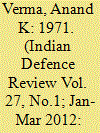

|
|
|
| 7 |
ID:
102291
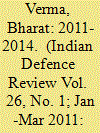

|
|
|
| 8 |
ID:
135583
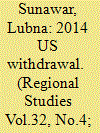

|
|
|
|
|
| Summary/Abstract |
The deployment of international troops in Afghanistan led by the US in 2001 brought new challenges for Pakistan to deal with. With American troops based in Afghanistan’s side of the border, the question of where the border was and Pakistan’s responsibilities for maintaining peace, law and order in its own territories acquired international attention. Militants were allegedly hiding on both sides of the border and were entering Pakistan through this porous border.
|
|
|
|
|
|
|
|
|
|
|
|
|
|
|
|
| 9 |
ID:
101029
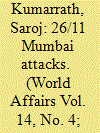

|
|
|
|
|
| Publication |
2010.
|
| Summary/Abstract |
For the Mumbai attacks of 26 November 2008, the Lashakr-e-Taiba recived training, funding and technical gadgets from the Inter-Service Intelligence (ISI) Pakistan, Middle East countries and United States (US) based companies restively. Fomenting insurgencies and supporting terrorism has been a major component of Pakistan's national strategy, especially against India. Yet t Indian security agencies are still badly trained and poorly equipped. Although, global cooperation is essential in combating international terrorism, the US has adopted selective rather than unified and comprehensive cunterterrorism measures to deal with this scourge in South Asia. It is no secret that the real rulers in Pakistan are the army and the ISI and at times they dwarf the civilian government in decision-making. If extremist forces take over Afghanistan and Pakistan, the world will become significantly less secure. However, international cooperation is not an entitlement and India must firs set its own house in order
|
|
|
|
|
|
|
|
|
|
|
|
|
|
|
|
| 10 |
ID:
102267
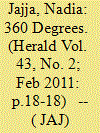

|
|
|
| 11 |
ID:
110996
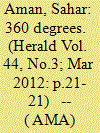

|
|
|
| 12 |
ID:
112196
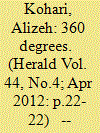

|
|
|
| 13 |
ID:
113632
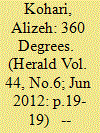

|
|
|
| 14 |
ID:
107394


|
|
|
| 15 |
ID:
099148
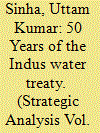

|
|
|
| 16 |
ID:
077767
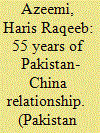

|
|
|
| 17 |
ID:
137493
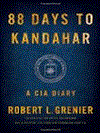

|
|
|
|
|
| Publication |
New York, Simon and Schuster, 2015.
|
| Description |
xix, 443p.Hbk.
|
| Standard Number |
9781476712079
|
|
|
|
|
|
|
|
|
|
|
|
Copies: C:1/I:0,R:0,Q:0
Circulation
| Accession# | Call# | Current Location | Status | Policy | Location |
| 058169 | 958.104/GRE 058169 | Main | On Shelf | General | |
|
|
|
|
| 18 |
ID:
057852
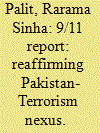

|
|
|
|
|
| Publication |
Jul-Sep 2004.
|
|
|
|
|
|
|
|
|
|
|
|
|
|
|
|
| 19 |
ID:
089984
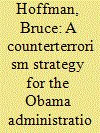

|
|
|
|
|
| Publication |
2009.
|
| Summary/Abstract |
This article assesses the scope and nature of the current terrorist threat to the United States and suggests a strategy to counter it. Al-Qaeda continues to pose the most serious terrorist threat to the U.S. today. If the September 11, 2001 attacks have taught us anything, it is that al-Qaeda is most dangerous when it has a sanctuary or safe haven from which to plan and plot attacks. Al-Qaeda has acquired such a sanctuary in Pakistan's Federal Administered Tribal Areas (FATA) and its North-West Frontier Province (NWFP) and surrounding environs. Accordingly, the highest priority for the new American presidential administration must be to refocus our-and our allies'-attention on Afghanistan and Pakistan, where al-Qaeda began to collapse after 2001, but has now re-grouped. This will entail understanding that al-Qaeda and its local militant jihadi allies cannot be defeated by military means alone. Success will require a dual strategy of systematically destroying and weakening enemy capabilities-that is, continuing to kill and capture al-Qaeda commanders and operatives-along with breaking the cycle of terrorist recruitment among radicalized "bunches of guys" as well as more effectively countering al-Qaeda's effective information operations. The U.S. thus requires a strategy that harnesses the overwhelming kinetic force of the American military as part of a comprehensive vision to transform other, non-kinetic instruments of national power in order to deal more effectively with irregular and unconventional threats. This article first discusses the scope and details of the terrorist threat today and then proposes a counterterrorism strategy for the new presidential administration. It focuses first on creating a micro approach to address the deteriorating situation in both Afghanistan and Pakistan. It then considers the requirements of a broader macro strategy to counter terrorism and insurgency.
|
|
|
|
|
|
|
|
|
|
|
|
|
|
|
|
| 20 |
ID:
084229
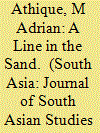

|
|
|
|
|
| Publication |
2008.
|
| Summary/Abstract |
This article examines the visualisation and narrative construction of the India-Pakistan border, and human interactions across that liminal space, as depicted in two films directed by J.P. Dutta, the high-profile, multiple award-winning war film Border (1997) and his subsequent feature Refugee (2000), which was more loosely described in its publicity literature as 'a human story'. 1 Through these films, Dutta established his reputation as the leading Indian director of the 'war film', a genre marked by its relative absence in the Indian cinema prior to the 1990s. Both Border and Refugee thus constitute part of what has retrospectively been described as Dutta's 'war trilogy' (along with the more recent LOC Kargil of 2003, which focuses on the 1999 Himalayan conflict). 2 In the first two films of the set, which I will consider here, the border in question is not the Line-of-Control (LOC) that divides Kashmir, but rather the southern portion of the long border with Pakistan that runs from the southern bank of the Sutlej River across the Thar Desert to the Arabian Sea. Refugee, moreover, is not a war film in the accepted sense, and I will make the argument that it is not so much the martial posturing which constructs the thematic inter-relation of the two films considered here but rather their attempts to naturalise the abstract barrier created by the Radcliffe Line in the west.
|
|
|
|
|
|
|
|
|
|
|
|
|
|
|
|